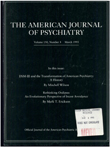Correlates of risk of suicide in violent and nonviolent psychiatric patients
Abstract
OBJECTIVE: This study was designed to identify variables that correlate with the risk of suicide in two patient groups that differ mainly in their level of expressed aggression. METHOD: Twenty-eight psychiatric patients with a history of violent behavior who were in a forensic psychiatric facility were tested and compared to 28 psychiatric inpatients without a history of violence who were admitted to a large municipal hospital. Measures used included a battery of self-report questionnaires, with acceptable reliability and validity, that provided indices of risk of suicide, risk of violence, impulsivity, anger, anxiety, and various mood states. RESULTS: The two groups, matched on demographic variables and overall risk of suicide, differed significantly on the measured risk of violence. The two groups showed similar patterns of correlations between risk of suicide and such variables as risk of violence, anger, fear, state and trait anxiety, lack of impulse control, suspiciousness, and rebelliousness. They differed in the correlation between suicide risk and depression. In the nonviolent patients there was a high correlation between risk of suicide and sadness; in the violent patients there was no correlation between these variables. CONCLUSIONS: The low correlation between sadness and risk of suicide in the violent patients, and the low prevalence of affective disorder diagnoses in these patients compared to other patients, suggests that suicidal risk should be managed differently in highly violent patients than in others.
Access content
To read the fulltext, please use one of the options below to sign in or purchase access.- Personal login
- Institutional Login
- Sign in via OpenAthens
- Register for access
-
Please login/register if you wish to pair your device and check access availability.
Not a subscriber?
PsychiatryOnline subscription options offer access to the DSM-5 library, books, journals, CME, and patient resources. This all-in-one virtual library provides psychiatrists and mental health professionals with key resources for diagnosis, treatment, research, and professional development.
Need more help? PsychiatryOnline Customer Service may be reached by emailing [email protected] or by calling 800-368-5777 (in the U.S.) or 703-907-7322 (outside the U.S.).



